Content of the article
- /01 What is a target and the principle of operation of targeted advertising
- /02 Main target formats
- /03 How to calculate an advertising budget for a target
- /04 Launching targeted advertising on Facebook
- /05 Launching targeted advertising on Instagram
- /06 We analyze the results of the target
- /07 To summarize
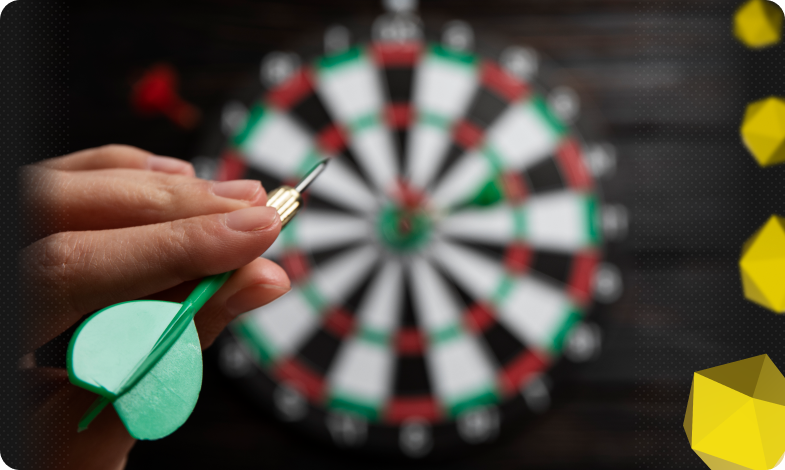
Targeted advertising is a digital marketing tool that allows advertisers to show ads to specific groups of people based on their interests, behaviors, demographics, and other parameters.
Almost everyone can set up a target using social media platforms. However, the result can vary greatly depending on the level of experience in setting up and understanding the target audience. Targeted advertising can be set up on social networks such as Facebook, Instagram, and Google’s advertising platforms.
In this article, we will take a detailed look at the topic of targeting and how to independently launch advertising on the social network Instagram and Facebook.
What is a target and the principle of operation of targeted advertising
Target is an English word that translates as “goal”. That is why targeted ads are shown to the target audience who can potentially perform the desired action, such as buying a product or signing up for a service.
The principle of targeted advertising is that an ad adjuster determines basic parameters such as age, gender, place of residence, interests and behavior of users in social networks in order to clearly outline the portrait of the target audience.
These settings allow you to customize your ad so that it is shown to those users who are most likely to take the desired action. If you have a detailed portrait of your target audience, it is almost impossible to waste your budget on ineffective ads. Properly configured targeted advertising can pay off 3-5 times, because it is shown to those people who are most interested in your offer.
Targeted advertising may appear in different locations depending on your ad campaign settings:
- One of the most common places is the social media feed, where users see ads that are organically integrated into their usual content.
- Stories in social networks, where ads can be presented in the form of short videos or images that easily attract the attention of users.
- Targeted ads often appear in social media recommendations, sites where users can see offers that match their previous interests and behavior.
This approach makes advertising more effective because it works with users’ interests and encourages them to interact.
To set up a target, you need to use various tools to collect and analyze user data. For example, analytics services that help understand the behavior and interests of the target audience. It is also worth connecting advertising managers that allow you to create and manage ads.
It is important to choose and configure these tools correctly so that advertising works as effectively as possible. The use of the target in thematic media is an important component of the marketing strategy.
The WEDEX team will help you set up a campaign that exactly meets the needs of your audience. We will conduct a thorough analysis, select the best platform for your business, and set up effective ads.Do you want to attract more customers through targeted advertising?
Main target formats
There are 4 target launch formats, each of which has its pros and cons.
- Universal recording
It is suitable for creating various advertising materials in social networks. It allows you to combine photos, videos, text content, links to external resources, polls to attract the audience, as well as display the location on the map. This format is customized for a specific audience in social networks.
- Carousel
An effective tool for launching dynamic advertising campaigns in social networks. These are multiple cards, each containing an image, text or link. This format of advertising for the target allows you to effectively present various aspects of the product or service, attracting the attention of the target audience.
- Advertising in stories
Stories are short videos or images that are displayed in a vertical format on social networks such as Instagram and Facebook. This advertising format will be effective in attracting the immediate attention of the audience.
- Lead Ads
A combination of an advertising block and a contact collection form. This advertising format allows you to collect contact data of the target audience without leaving the social network, which simplifies the process of attracting new customers.
To achieve better results, it is necessary to correctly combine these advertising formats in social networks and make adjustments, taking into account all the details of the portrait of the target audience.
We create a portrait of the target audience
For effective targeting, it is important to create a clear portrait of the target audience, reflecting its demographic and psychographic characteristics.
- Data collection
Use questionnaires, analytics and information about customers who have already purchased from you. Demographics such as age, gender, place of residence and occupation will help you understand the basic characteristics of your audience. - Psychographic portrait
This is information about the lifestyles, interests, values and behavioral characteristics of your target audience. Consider what interests and hobbies your potential customers have, what platforms they use to consume content, and which social networks they visit most often. This information will help you create more personalized communications and advertising. - Behavioral factor
Where and how often they shop, which sales channels they prefer, whether they tend to shop online or choose brick-and-mortar stores. This information will allow you to fine-tune your targeted advertising campaigns, finding customers where they are most actively buying.
After collecting all the necessary information, divide it into groups, creating different portraits of consumers.
For example, write it like this:
“Maria, 34 years old, works as a school teacher. Lives in Lviv, hobbies include yoga and books. In social networks, she watches videos about sports and healthy eating, subscribes to channels about health, nutrition, books and teaching at school.”
Such a detailed portrait will help you adjust your social media advertising campaigns to best suit the interests and needs of your target audience.
How to calculate an advertising budget for a target
For effective planning of the advertising budget, it is first necessary to determine the purpose of the campaign. For example, it can be an increase in sales by 20% in half a year. Next, you will need several key indicators for the calculation:
- Average check: for example, the average check on your site is 1000 hryvnias.
- The amount you are willing to spend to attract one client: let’s say you are willing to spend 200 hryvnias.
- CR (Conversion Rate) – conversion: for example, your current conversion rate is 5%.
Budget calculation
Step 1. Calculation of total revenue from sales
Expected Number of Orders = Increase in Sales / Average Check = 20% × Current Sales / 1000
For example, if the current volume of sales is 500,000 hryvnias, then:
Number of orders = 20% × 500,000 / 1000 = 100
Total revenue from sales = Number of orders × Average check = 100 × 1000 = 100,000 hryvnias
Step 2. Determining the preliminary campaign budget
Preliminary amount of the budget = Amount you are ready to spend on the client × Number of orders = 200 × 100 = 20,000 hryvnias
Step 3. Calculation of the amount of traffic that should be attracted to the site
Number of traffic = Number of orders / CR = 100 / 5% = 2000
Step 4. Calculation of rates
CPM (cost per mille) — the price for 1000 impressions
CPM = (10,000 / 50,000) × 1000 = 200 hryvnias
CPC (Cost Per Conversion) is the average price per click
CPC = 10,000 / 2,000 = 5 hryvnias
Using these metrics and formulas, you can effectively calculate your advertising budget and set goals for your campaign, ensuring optimal use of resources and achievement of your goals.
Launching targeted advertising on Facebook
Follow the steps below if you want to try running a Facebook target yourself. Prepare pictures and text for ads in advance and develop a portrait of the target audience.
1. Log in to your Facebook business account and go to the advertising cabinet:
- log in to your personal Facebook account;
- in the upper right corner of the page, click on the down arrow or on the menu icon and select “Facebook advertising”;
- you will be taken to the main page of the advertising cabinet, where you will see a hierarchy of campaigns, ad groups and individual ads.
2. Choose the goal of your advertising campaign:
- Facebook offers different goals for your ads that help you focus on specific results. They are divided into three categories: Recognition, Acquaintance and Conversion;
- for example, you can choose the goal of increasing web traffic, increasing brand awareness, getting referrals for consulting, increasing the number of conversions on your site, etc.

3. Set up an audience:
- choose who will see your ads. Use the data you have collected about your target audience: demographic data (age, gender, place of residence), interests, behavioral data (such as Facebook interests) and other criteria;
- it is important to create an accurate and diverse portrait of your ideal consumer for the most effective targeting.

4. Choose a placement (the place-to-place ads in social networks):
- choose exactly where you want to show your ads;
- Facebook offers different places to post: news feed on desktop and mobile, stories, right column, featured posts and other platforms.
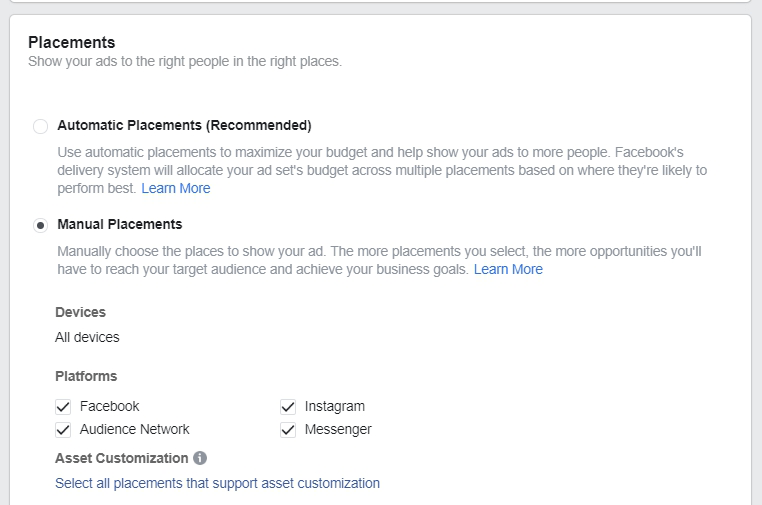
5. Specify the budget:
- set how much you are willing to spend on your social media advertising campaign. You can set a daily budget or a budget for a certain period of time, for example, a week or a month;
- it is important to consider that the budget should correspond to your goals and capabilities.
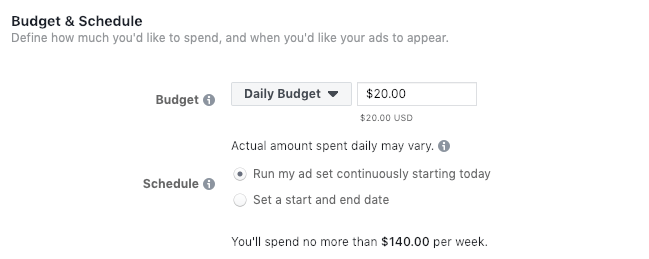
6. Choose optimization to display ads
It is important to choose the option that best suits your goals and is able to provide the best results.
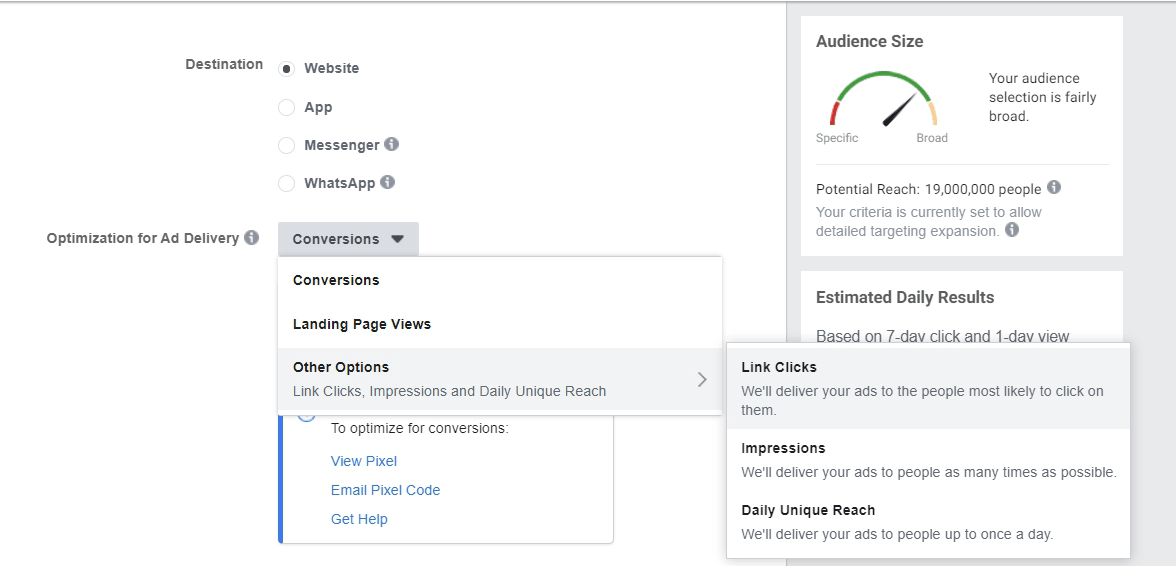
7. Create an ad:
- choose the ad format according to your strategy: photo, video, carousel or slideshow;
- consider the requirements for each format, such as image sizes, acceptable text, compliance with Facebook’s content standards.

8. Run an ad:
- check all settings, preview ads, make sure everything is set up just the way you want it;
- click the “Publish” button.
These steps allow you to plan, configure and run targeted Facebook ads with maximum efficiency and effectiveness for your business.
Launching targeted advertising on Instagram
It is very easy to run ads on the Instagram social network yourself. To do this, you need to follow the simple steps described below.
- Switch to your Instagram business profile.
This can be done in the account settings. The business profile provides the ability to use advanced tools for advertising, analytics and reporting. - Select a publication to promote.
Select one of the posts in your profile feed that you want to promote to your target audience.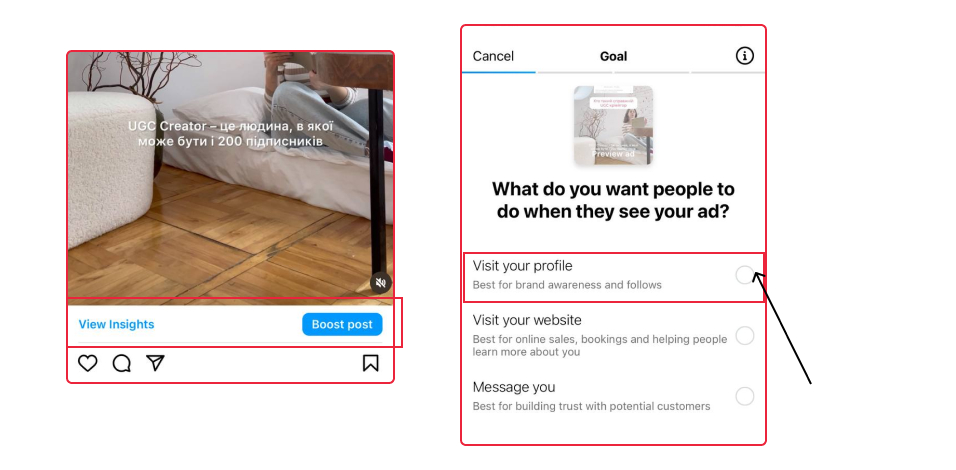
- Click the “Promote” button.
- Set up your audience.
Select your target audience using a prepared consumer portrait. Set parameters such as age, location, interests and behavioral characteristics for the most accurate targeting.
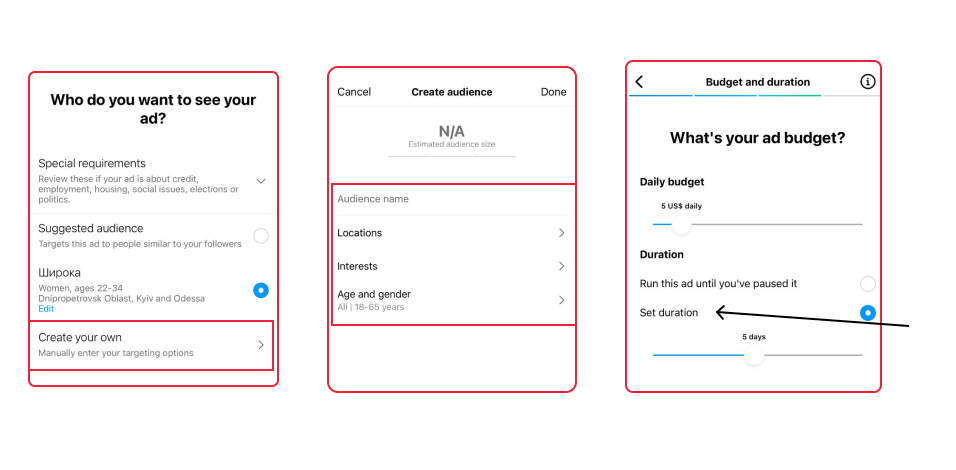
Instagram has two placements:
- Tape
Ads appear between organic posts and can contain photos, videos or image carousels. This allows you to capture the attention of users viewing your social media feed and engage with them through your content. - Stories
Ads are placed in the cross-functional section of Instagram, where users view full-screen photos or videos that are actively used in everyday life. This format is especially effective for instant offers and audience engagement.
Instagram advertising is a powerful tool for attracting the attention of your target audience and increasing brand awareness.
We analyze the results of the target
One of the main stages of analyzing targeted advertising is tracking metrics such as impressions, reach and clicks.
- Impressions represent the number of times your targeted ad was shown to users on social networks.
Example, if your targeted ad has been seen 10,000 times, it means that your targeted ad has reached a significant audience. - Reach determines the number of unique users who saw your targeted ad.
Example, if a targeted ad was shown 10,000 times, but the reach was only 8,000, it means that some users saw the ad multiple times. - Clicks on a targeted ad help you understand how attractive it is to your target audience on social networks.
Example, if you received 500 clicks out of 10,000 impressions, this may indicate a high level of user engagement. - Click-through rate (CTR) is an important metric and shows what percentage of users clicked on a targeted ad after viewing it on social media.
Example, if your CTR is 5%, it means that out of every 100 impressions, 5 users clicked on your target ad. A high CTR indicates that your ad is attractive and effective enough to engage with social media users. - The number of conversions is one of the key indicators of the effectiveness of targeted advertising, as it directly indicates the success of your advertising campaign in achieving its goals. Conversions show different targeted actions, such as purchasing a product, registering for a webinar, or signing up for a newsletter.
Example, if you sell online courses and get 50 new signups through your targeted ad campaign, that would count as 50 conversions. Conversion tracking allows you to understand how effectively your targeted advertising leads to the desired actions on the part of users. - Pricing metrics: cost per click (CPC), cost per conversion, and cost per lead are critical to managing your targeted social media campaign budget.
Example, if the cost per click on a targeted ad is $1 and you get 100 clicks, then you’ve spent $100 on user acquisition. The cost of conversion allows you to estimate how much it costs you to attract one buyer or client. If the cost of conversion is acceptable to you, and you receive income that exceeds costs, then the targeted campaign can be considered a success. - Return on advertising investment – ROAS. Shows how much revenue you got for every dollar spent on targeted advertising.
Example, if you spent $200 on advertising and got $800 in revenue, your ROAS is 4. This means you got $4 in revenue for every dollar you spent. This indicator allows you to assess how effective your targeted advertising is in terms of financial results in social networks.
Before launching a social media advertising campaign, it’s important to identify the key performance indicators (KPIs) that are most important to you and set spending caps that you don’t want to exceed.
For example, you can set the cost of a click to be no more than $1. Then, throughout the campaign, it will be necessary to constantly analyze the results and adjust the settings to adhere to these parameters and ensure the maximum effectiveness of your targeted social media advertising activities.
Mistakes in targeted advertising
Mistakes happen when running social media ads, yourself, especially if you’re doing it for the first time. So, we offer to look them straight “in the eye”. Although sometimes target specialists can do some of them.
- Abuse of the list of interests
Some believe that the more interests are specified, the more precisely targeting will work and the target audience will be found. In fact, it is not. Algorithms for advertising platforms on social networks such as Instagram and Facebook work best when the list of interests is limited to a few key groups, usually two or three. Overloading the list of interests leads to audience fragmentation and increases the risk of showing ads to an untargeted group of users. This can negatively affect the effectiveness of the target, leading to high costs and low conversion. Optimal use of the list of interests allows algorithms to better analyze user behavior and find those who are most likely to be interested in your offer. - An error in the selection of the target of advertising
Each advertising campaign in social networks should have a clearly defined goal: increase sales, promotion brand recognition, attraction of new customers or other. However, it often happens that the goal is chosen incorrectly or is not formulated clearly enough. For example, if your main goal is to increase conversions to a thematic site, setting up a campaign with an emphasis on attracting traffic (site visits) will not be effective. It is important to understand that each advertising goal has its own optimization algorithms that are aimed at achieving specific results. An incorrectly chosen goal leads to a waste of the budget and can give false data about the effectiveness of the target, which complicates further analysis and optimization. - Insufficient budget
Budget planning is one of the first stages in setting a target. Insufficient budget is often the reason that ads are not optimized to be shown to their target audience to ensure the desired result. This may be the result of miscalculating the cost of a click, conversion, or reach. For example, market specifications, seasonality or competition are not sufficiently taken into account, which can significantly affect the cost of advertising. - Facebook Pixel not connected (if the ad leads to a website)
This is an analytics tool that allows you to track the actions of users on the site after interacting with your Facebook ads. It collects data about page visits, purchases, registrations and other important actions, which helps to set up precise targeting and optimization of advertising campaigns. Thanks to this, you can more effectively attract new customers, increase conversions and use the advertising budget as efficiently as possible.
Consider these mistakes and try not to make them. And it is even better to entrust the setting of target advertising to specialists with experience, who will give guaranteed results and will not drain the budget.
To summarize
Targeted advertising helps in solving more than one business task: from improving brand recognition to increasing conversions. Algorithms of advertising platforms have a large number of options in stock for finding and targeting exactly those consumers that you want to “reach”. The main aspect in this matter is to know the key qualities of your target audience and choose creatives and formats that are exciting and useful for them.






 09/07/2024
09/07/2024  3287
3287



